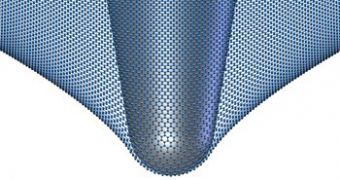Carbon sheets only one atom thick, also known as graphene, became a wonder material in 2004 when they were first discovered and maintained their status ever since, showing good electrical and thermal conductivity as well as semiconductor properties. Now, defect-free graphene monolayers were also proven to possess exceptional strength, which makes them some of the strongest known materials in the world.
All materials possess an intrinsic strength, given by the maximum force required to pull their atoms apart in a given cross section. However, measuring this breaking stress is most of the time difficult because virtually all materials contain defects that weaken them in certain areas. To get an accurate measurement of the intrinsic strength of a particular material, one has to measure the stress at a microscopic level, rather than that of the macroscopic structure whose breaking stress is largely related to the number and sizes of the defects inside it.
The experiment carried out by researchers James Home, Kysar Changgu Lee and Xiaoding Wei of the Columbia University began like any other procedure used to create monolayer graphene. With the help of transparent sticky tape and a source of graphite, individual atomic layers of graphene were exfoliated and then placed over a silicon wafer containing a series of holes between 1 and 1.5 micrometers across. "Each graphene film is like a small drum, except that the drumhead is only one atomic layer thick," said Kysar.
Then the graphene sheet was indented with a diamond tip 20 nanometers across in order to determine the force displacement response of the film, which was then used to evaluate the elastic properties of the material and finally its intrinsic strength. "The stiffness of graphene is literally 'off the chart' when compared to other classes of material. This is thanks to both the covalent carbon-carbon bonds in graphene as well as the absence of any defects in the highest stressed portion of the graphene films," Hone said.
Since the experiment was carried out with very small graphene monolayers, they were considered defect free and knowing the strength of the covalent carbon-carbon bond, it may be possible that graphene is the strongest known material, the team said. "The intrinsic strength of graphene can be considered as an 'upper bound' for the strength of materials - rather like diamond is for hardness - that could serve as a goal for engineers who design materials. The new result will also serve as an experimental 'benchmark' to validate various theories and computer models that predict the elastic properties of materials at very high strains," added Hone.
He further states that if a sheet of cling film with a thickness of about 100 micrometers had the strength of graphene sheets, it would required a force greater than 20,000 Newtons to puncture it on a surface area comparable to that of the tip of a pencil, or roughly the force exerted by an object with a mass of 2,000 kilograms. Current experiments conducted by the team have the role of establishing the friction properties and the van der Walls forces exerted between graphene and the substrate.

 14 DAY TRIAL //
14 DAY TRIAL //